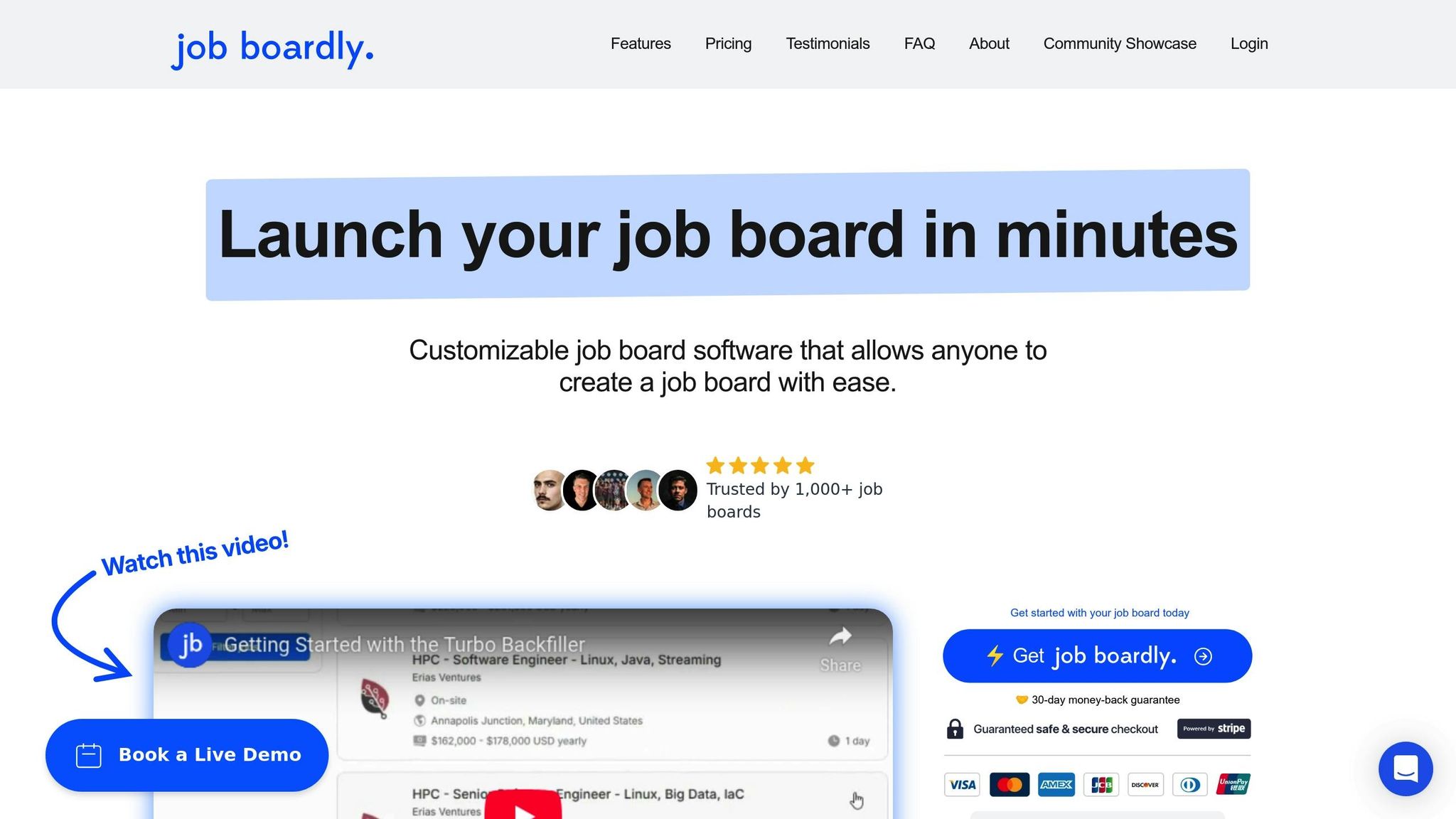SEO-Friendly URL Structure: Examples for Job Boards
SEO-friendly URLs are critical for job boards to rank higher on search engines and improve user experience. A clear and concise URL structure helps job seekers and search engines easily understand the content of your pages. For instance, a URL like /marketing-jobs/chicago-il/senior-manager is far more effective than /jobs?id=12345. Here are the key takeaways:
-
Keep URLs clear and logical: Use a hierarchy like
/category/location/job-titleto make navigation intuitive. - Include relevant keywords: Keywords like job type, location, and title boost search visibility.
- Maintain consistent formatting: Use lowercase letters, hyphens instead of spaces, and avoid special characters.
-
Avoid messy parameters: Opt for static URLs like
/tech-jobs/new-york-cityinstead of?category=tech&location=nyc. - Shorter URLs perform better: Aim for URLs under 60 characters for better readability and ranking.
- Prevent duplicate content: Use canonical tags to consolidate ranking signals.
Platforms like Job Boardly simplify this process with automated tools, while a manual approach offers more customization for advanced users. Both methods have their pros and cons, depending on your technical expertise and goals.
Quick Comparison:
| Feature | Job Boardly (Automated) | Manual Setup (Custom) |
|---|---|---|
| URL Clarity | Automatically generated, simple | Fully customizable |
| Keyword Integration | Built-in tools | Requires manual research |
| Scalability | Automatic as content grows | Manual adjustments needed |
| Canonicalization | Automated management | Requires manual setup |
| Cost | $40/month | Higher upfront and maintenance cost |
Whether you choose automation or a manual setup, a well-structured URL strategy is essential for your job board’s success. Start with clean, descriptive URLs to improve search rankings and user trust.
Perfect URL Structure for SEO - Ignite Visibility

SEO-Friendly URL Structure Basics for Job Boards
When it comes to crafting URLs for job boards, there are a few essential principles that can boost your search engine rankings and improve user experience. Whether you're working on category pages, location-specific listings, or individual job postings, these guidelines will help you create URLs that are both effective and user-friendly.
Clear hierarchy is key. Your URLs should follow a logical structure that mirrors how users naturally search for jobs. Start broad and narrow down to specific details. For example: /healthcare-jobs/california/registered-nurse-icu. This layout makes it easy for both users and search engines to navigate your site.
Keyword placement matters. Including relevant keywords in your URLs can improve search visibility, especially when those keywords reflect real search terms. For instance, use "remote-software-engineer" instead of internal codes or generic labels. Place important keywords - like job categories and locations - early in the URL path for maximum impact.
Consistent formatting ensures uniformity across your job board. Stick to hyphens for spaces, use lowercase letters, and avoid special characters. For example, a job titled "Senior Marketing Manager - Remote (SF Bay Area)" should translate to /marketing-jobs/remote/senior-marketing-manager-sf-bay-area.
Logical organization makes it easier for job seekers to browse. Most users start their search with either a job category or location and then drill down further. Reflect this behavior in your URLs. For example:
-
Listings:
/[category]/[location]/[job-title] -
Filter results:
/[category]/[location]
For different page types, follow these structures:
-
Category pages: Use simple URLs like
/engineering-jobsor/healthcare-careers. -
Location pages: Include state abbreviations or city names, such as
/jobs/austin-txor/remote-jobs. - Individual job listings: Combine category, location, and job title. Keep these URLs detailed but concise, ideally under 60 characters.
Parameter handling is another critical aspect, especially for job boards with filtering options. Instead of relying on query parameters like ?category=tech&location=nyc, opt for clean, static URLs such as /tech-jobs/new-york-city. This makes filtered pages more indexable and shareable. If advanced filters require parameters, ensure your primary category and location pages remain clean and static.
URL length also plays a role in user experience, particularly for mobile users. Shorter URLs with focused keywords are easier to read and share, especially on mobile screens. Aim to keep your most important keywords within the first 50 characters of the URL path to avoid truncation.
Finally, prevent duplicate content by designating a primary URL for each job posting and using canonical tags. This helps search engines consolidate ranking signals and ensures they recognize your preferred URL version, avoiding any penalties for duplicate content.
1. Job Boardly

Job Boardly demonstrates how no-code platforms can easily incorporate SEO-friendly features into their design. With built-in tools, it helps users create clean, search-friendly URLs that adhere to best practices while staying adaptable to various niche markets.
URL Clarity
One of Job Boardly's standout features is its commitment to clear and readable URLs. These URLs not only make navigation intuitive for users but also improve search engine understanding. By supporting custom domains, Job Boardly ensures businesses can maintain brand consistency while keeping URL structures straightforward - helping job seekers instantly grasp where they are on the site.
Keyword Integration
Job Boardly takes its URL strategy a step further by seamlessly integrating relevant keywords. For instance, URLs like /nursing-jobs/texas reflect common search terms, combining job categories and locations to enhance visibility. The platform's tools, such as Magic Aggregator and Turbo Backfiller, ensure that imported job listings follow consistent URL formats. This prevents the clutter of mixed structures, which could otherwise hinder search engine performance.
Scalability
As job boards expand, Job Boardly keeps pace by automatically generating new pages for categories and locations. This ensures that SEO performance remains strong, regardless of the board's growth. Plus, with multi-language support, job board owners can create region-specific URLs while maintaining the same clear organizational structure - making the platform a solid choice for global reach.
sbb-itb-316a34c
2. Example SEO-Optimized Job Board
Let’s dive into a practical example of advanced SEO techniques in action. This case study highlights how well-structured URLs can enhance both search engine rankings and user experience.
Meet TechCareers Hub, a fictional job board focused on technology roles. It’s an excellent example of how thoughtful URL design can make a big difference.
URL Clarity
TechCareers Hub prioritizes clear and intuitive URLs that immediately convey the page’s purpose to both users and search engines. For instance:
- The homepage is simply techcareershub.com, keeping it neat and straightforward.
-
Job category pages follow a logical structure like
/software-developer-jobsor/data-scientist-positions. -
Individual job listings use descriptive URLs such as
/jobs/senior-python-developer-remote-google-2024. This format instantly tells users what the page is about.
Additionally, they avoid messy parameters in their URLs. For example, paths like /tech-jobs/new-york/manhattan are clean, easy to share, and memorable. This simplicity encourages users to bookmark or share specific job searches with others.
On top of clarity, the strategic use of keywords in URLs further boosts their SEO performance.
Keyword Optimization
TechCareers Hub incorporates relevant keywords directly into their URLs to target job seekers’ common search phrases. A few examples include:
-
Location-specific URLs like
/remote-jobs/usaor/startup-jobs/silicon-valleycater to popular search queries. -
By analyzing trends, they noticed spikes in searches for "remote software engineer jobs" and created dedicated URLs like
/remote-software-engineer-jobsto capture that traffic.
For company-specific searches, they use URLs like /companies/microsoft-careers, combining the company name with job-related keywords to rank higher for branded queries. Even salary-related content is optimized with paths like /software-engineer-salary/california.
This keyword-focused approach helps TechCareers Hub match user intent while improving visibility on search engines.
Scalability
The job board’s URL structure is designed to grow effortlessly as new categories or locations are added. For instance:
-
When blockchain roles became popular, they quickly generated a page like
/blockchain-developer-jobswithout disrupting their existing structure. -
They automatically create location-specific pages, such as
/javascript-jobs/austin-texas, for cities with over 50 active job postings.
For international audiences, they use subdirectories to keep content organized while maintaining domain authority. Examples include:
-
/ca/toronto-jobsfor Canada -
/uk/london-tech-jobsfor the United Kingdom
As new job types emerge, their system seamlessly generates category pages and maintains consistent internal links. This scalability ensures their site remains organized and SEO-friendly as it grows.
Canonicalization Support
TechCareers Hub also excels in managing duplicate content through canonicalization. Here’s how they handle it:
-
If the same job appears in multiple categories, they designate a single canonical URL like
/jobs/senior-react-developer-facebook-menlo-park. Other versions, such as/react-jobs/senior-react-developer-facebook-menlo-park, include canonical tags pointing to the main URL. -
Search result pages use self-referencing canonicals to consolidate ranking signals. For filtered searches, they decide which filters deserve unique URLs (e.g.,
/entry-level-software-jobs) and which should point to broader category pages.
These measures prevent content duplication and ensure their SEO efforts remain focused, maximizing the impact of their URL strategy.
Pros and Cons
Let’s dive into the pros and cons of two different approaches to URL structuring: using Job Boardly's automated system versus a manually implemented, SEO-optimized structure. This comparison is crucial for job board owners aiming to make smart decisions about their site's architecture.
| Feature | Job Boardly | Example SEO-Optimized Job Board |
|---|---|---|
| URL Clarity | Simple and intuitive navigation paths | Descriptive URLs that clearly define the page's purpose |
| Keyword Optimization | Built-in tools automatically integrate SEO keywords | Requires manual research and configuration of keywords |
| Scalability | Automatically adapts as content grows | Needs manual adjustments for new categories or content |
| Canonicalization Support | Automated management to avoid duplicate content issues | Relies on manually setting canonical tags |
The table above highlights key differences, which we’ll explore in more detail below.
Strengths of Job Boardly
Job Boardly shines when it comes to automation. Its built-in SEO tools handle technical tasks like generating clean, user-friendly URLs, even if you don’t have a technical background. This means you can focus on creating content while the platform takes care of the structural SEO.
The platform’s no-code setup is another major advantage. You can launch a professional job board with optimized URLs in just a few hours, not weeks. Plus, its automated canonicalization ensures duplicate content issues are minimized without requiring manual intervention.
Limitations of Job Boardly
That said, Job Boardly’s automation might feel restrictive for advanced users. If you want full control over your URL structure or need to make highly customized adjustments, the platform’s automated approach could feel limiting.
Strengths of a Manually SEO-Optimized Job Board
A manual approach offers unmatched flexibility. You can design URLs that perfectly align with your keyword strategy and content goals. This allows for precise customization, whether it’s tailoring canonical tags or creating a unique category hierarchy. For those with the technical know-how, this approach can lead to a highly refined SEO setup.
Limitations of a Manually SEO-Optimized Job Board
However, this flexibility comes with a cost. Manual implementation requires a deep understanding of SEO and technical expertise. It’s also time-consuming and prone to errors, meaning regular maintenance is crucial to keep everything running smoothly.
Cost Breakdown
Job Boardly offers a budget-friendly solution at $40 per month, providing an optimized URL structure without the need for technical resources. On the other hand, a custom manual system involves higher upfront costs and ongoing expenses for technical support and maintenance.
Ultimately, the right choice depends on your business needs and available resources. For broad-based job boards, Job Boardly’s efficient and quick setup is a great fit. But if you’re building a niche platform with specialized requirements - and have the expertise and budget to back it up - a manual approach might be worth considering.
Conclusion
Creating SEO-friendly URLs for your job board doesn’t have to feel like a daunting task. It’s all about striking the right balance between optimizing for search engines and keeping things practical for your specific needs.
Both automated and manual approaches have their advantages. Automated tools like Job Boardly take care of the technical details for $40 per month, making them a great choice for entrepreneurs who’d rather focus on growing their platform than diving into URL configurations. On the other hand, a manual setup offers greater customization but requires technical know-how and ongoing maintenance. While this approach gives you full control, it can also demand more time and lead to higher costs in the long run.
To make implementation smoother, follow a few key practices: aim for URLs under 60 characters, use hyphens instead of underscores, and stick to a consistent category structure. Including essential details like location and job type in your URLs is crucial since those are often the terms job seekers search for. As your job board scales, automated systems can also help you avoid duplicate content issues, which can harm your search rankings.
Ultimately, your choice should align with your business goals and technical expertise. If you’re launching a niche job board and want to keep things simple while maintaining strong SEO, an automated solution like Job Boardly could be the way to go. For those who need more customization and have the technical skills to manage it, a manual approach might be worth the extra effort.
Whether you opt for automation or a hands-on setup, starting with clean, user-friendly URLs is critical. A well-thought-out, scalable URL structure not only boosts your job board’s search engine visibility but also builds trust with users - setting the stage for long-term success.
FAQs
How can an SEO-friendly URL structure help improve a job board's search rankings?
An SEO-friendly URL structure plays a key role in boosting a job board's search rankings. Clear, concise, and descriptive URLs that include relevant keywords make it easier for search engines to understand what your page is about. This improves indexing and helps your site gain more visibility in search results.
On top of that, well-structured URLs enhance the user experience. Visitors find it easier to navigate your site, which can lead to higher click-through rates and longer time spent on your pages - both of which are factors that can positively impact SEO.
What are the advantages of using Job Boardly to automate URL management instead of handling it manually?
Using Job Boardly to handle URL management automatically offers several advantages compared to doing it manually. First, it saves you a ton of time and effort by simplifying the process of creating and maintaining URLs that are optimized for SEO. These URLs are clear, descriptive, and consistent - qualities that are especially critical for large job boards. When you're dealing with a high volume of URLs, manual management can quickly become overwhelming and prone to mistakes.
Automation also reduces the risk of human error and ensures uniformity across all your URLs, which is a big deal for SEO performance. Plus, it supports scalability, so as your content grows, you can keep up without sacrificing quality or efficiency. In short, Job Boardly takes the hassle out of URL management, making the process faster, more accurate, and SEO-friendly.
What mistakes should I avoid when creating SEO-friendly URLs for job boards?
When crafting SEO-friendly URLs for job boards, it's best to keep things simple and clean. Avoid adding unnecessary elements like special characters, stop words (such as "and" or "the"), or strings of random numbers. These extras not only make URLs harder to read but can also create challenges for search engines trying to index your pages.
It's also wise to stay away from generic or vague URLs. Instead, focus on including descriptive keywords that clearly communicate the content of the page. This approach not only helps search engines understand your site but can also boost its visibility. Lastly, steer clear of overly complicated URL structures filled with unnecessary parameters - clean and straightforward URLs work better for both users and SEO.
